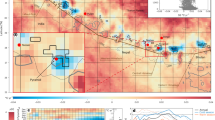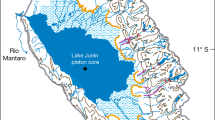Abstract
The causes and timing of tropical glacier fluctuations during the Holocene epoch (10,000 years ago to present) are poorly understood. Yet constraining their sensitivity to changes in climate1 is important, as these glaciers are both sensitive indicators of climate change and serve as water reservoirs for highland regions2. Studies have so far documented extra-tropical glacier fluctuations3,4, but in the tropics, glacier–climate relationships are insufficiently understood. Here we present a 10Be chronology for the past 11,000 years (11 kyr), using 57 moraines from the Bolivian Telata glacier (in the Cordillera Real mountain range). This chronology indicates that Telata glacier retreated irregularly. A rapid and strong melting from the maximum extent occurred from 10.8 ± 0.9 to 8.5 ± 0.4 kyr ago, followed by a slower retreat until the Little Ice Age, about 200 years ago. A dramatic increase in the rate of retreat occurred over the twentieth century. A glacier–climate model indicates that, relative to modern climate, annual mean temperature for the Telata glacier region was −3.3 ± 0.8 °C cooler at 11 kyr ago and remained −2.1 ± 0.8 °C cooler until the end of the Little Ice Age. We suggest that long-term warming of the eastern tropical Pacific and increased atmospheric temperature in response to enhanced austral summer insolation were the main drivers for the long-term Holocene retreat of glaciers in the southern tropics.
This is a preview of subscription content, access via your institution
Access options
Subscribe to this journal
Receive 51 print issues and online access
$199.00 per year
only $3.90 per issue
Buy this article
- Purchase on Springer Link
- Instant access to full article PDF
Prices may be subject to local taxes which are calculated during checkout




Similar content being viewed by others
References
Vuille, M. et al. Climate change and tropical Andean glaciers: past, present and future. Earth Sci. Rev. 89, 79–96 (2008)
Kaser, G. & Osmaston, H. Tropical Glaciers (Cambridge Univ. Press, 2002)
Mayewski, P. A. et al. Holocene climate variability. Quat. Res. 62, 243–255 (2004)
Schaefer, J. M. et al. High-frequency Holocene glacier fluctuations in New Zealand differ from the northern signature. Science 324, 622–625 (2009)
Smith, C. A., Lowell, T. V., Owen, L. A. & Caffee, M. W. Late Quaternary glacial chronology on Nevado Illimani, Bolivia, and the implications for paleoclimatic reconstructions across the Andes. Quat. Res. 75, 1–10 (2011)
Glasser, N. F., Clemmens, S., Schnabel, C., Fenton, C. R. & McHargue, L. Tropical glacier fluctuations in the Cordillera Blanca, Peru between 12.5 and 7.6 ka from cosmogenic 10Be dating. Quat. Sci. Rev. 28, 3448–3458 (2009)
Licciardi, J. M., Schaefer, J. M., Taggart, J. R. & Lund, D. C. Holocene glacier fluctuations in the Peruvian Andes indicate northern climate linkages. Science 325, 1677–1679 (2009)
Rodbell, D. T., Smith, J. A. & Mark, B. G. Glaciation in the Andes during the late glacial and Holocene. Quat. Sci. Rev. 28, 2165–2212 (2009)
Buffen, A. M., Thompson, L. G., Mosley-Thompson, E. & Huh, K. I. Recently exposed vegetation reveals Holocene changes in the extent of the Quelccaya Ice Cap, Peru. Quat. Res. 72, 157–163 (2009)
Abbott, M. B. et al. Holocene paleohydrology and glacial history of the central Andes using multiproxy lake sediment studies. Palaeogeogr. Palaeoclimatol. Palaeoecol. 194, 123–138 (2003)
Rodbell, D. T., Seltzer, G. O., Mark, B. G., Smith, J. A. & Abbott, M. B. Clastic sediment flux to tropical Andean lakes: records of glaciation and soil erosion. Quat. Sci. Rev. 27, 1612–1626 (2008)
Jomelli, V. et al. Fluctuations of Andean tropical glaciers since the last millennium and palaeoclimatic implication: a review. Palaeogeogr. Palaeoclimatol. Palaeoecol. 281, 269–282 (2009)
Rabatel, A., Francou, B., Jomelli, V., Naveau, P. & Grancher, D. A chronology of the Little Ice Age in the tropical Andes of Bolivia (16°S) based on moraines by lichenometry: implication for climate reconstruction. Quat. Res. 70, 198–212 (2008)
Blard, P. H., Lavé, J., Pik, R., Wagnon, P. & Bourles, D. Persistence of full glacial conditions in the central Pacific until 15,000 years ago. Nature 449, 591–594 (2007)
Wagnon, P., Ribstein, P., Francou, B. & Sicart, J. E. Anomalous heat and mass budget of Glaciar Zongo, Bolivia, during the 1997–98 El Niño year. J. Glaciol. 47, 21–28 (2001)
Favier, V., Wagnon, P. & Ribstein, P. Glaciers of the outer and inner tropics: a different behavior but a common response to climatic forcing. Geophys. Res. Lett. 31 L16403 10.1029/2004GL020654 (2004)
Sicart, J. E., Hock, R. & Six, D. Glacier melt, air temperature and energy balance in different climates: the Bolivian Tropics, the French Alps, and northern Sweden. J. Geophys. Res. 113 D24113 10.1029/2008JD010406 (2008)
Braconnot, P., Marzin, C., Grègoire, L., Mosquet, E. & Marti, O. Monsoon response to changes in Earth's orbital parameters: comparisons between simulations of the Eemian and of the Holocene. Clim. Past 4, 281–294 (2008)
Cruz, F. W. et al. Orbitally driven east–west antiphasing of South American precipitation. Nature Geosci. 2, 210–214 (2009)
Baker, P. A. et al. The history of South American tropical precipitation for the past 25,000 years. Science 291, 640–643 (2001)
Condom, T. et al. Transient modelling of lacustrine regressions: two case studies from the Andean Altiplano. Hydrol. Process. 18, 2395–2408 (2004)
Garreaud, R., Vuille, M. & Clement, A. The climate of the Altiplano: observed current conditions and mechanisms of past changes. Palaeogeogr. Palaeoclimatol. Palaeoecol. 194, 5–22 (2003)
Haug, G. H., Hughen, K. A., Sigman, D. M., Peterson, L. C. & Röhl, U. Southward migration of the intertropical convergence zone through the Holocene. Science 293, 1304–1308 (2001)
Kienast, M. et al. Eastern Pacific cooling and Atlantic overturning circulation during the last deglaciation. Nature 443, 846–849 (2006)
Kageyama, M. et al. Glacial climate sensitivity to different states of the Atlantic meridional overturning circulation: results from the IPSL model. Clim. Past 5, 551–570 (2009)
Kull, C., Imhof, S., Grosjean, M., Zech, R. & Veit, H. Late Pleistocene glaciation in the Central Andes: temperature versus humidity control: a case study from the eastern Bolivian Andes (17°S) and regional synthesis. Global Planet. Change 60, 148–164 (2008)
Francou, B., Vuille, M., Wagnon, P., Mendoza, J. & Sicart, J. E. Tropical climate change recorded by a glacier in the central Andes during the last decades of the twentieth century: Chacaltaya, Bolivia, 16-S. J. Geophys. Res. 108 4154 10.1029/2002JD002959 (2003)
Bradley, R. S., Vuille, M., Diaz, H. F. & Vergara, W. Threats to water supplies in the tropical Andes. Science 312, 1775–1755 (2006)
Urrutia, R. & Vuille, M. Climate change projections for the tropical Andes using a regional climate model: temperature and precipitation simulations for the end of the 21st century. J. Geophys. Res. 114 D02108 10.1029/2008JD011021 (2009)
Acknowledgements
Financial support was provided by the French INSU programme ‘LEVE’, the French ANR Escarcel programme no. 06-Vuln-010, UR Great Ice at IRD, and the French ANR El Paso programme no. 10-Blan-608-01. We thank P. Ginot, E. Perroy, E. Ramirez and the Bolivian authorities for facilitating our field work in the Zongo valley. The 10Be measurements were performed at the ASTER AMS national facility (CEREGE, Aix en Provence), which is supported by INSU/CNRS, the French Ministry of Research and Higher Education, IRD and CEA. We are grateful to L. Léanni for handling the necessary physical and chemical preparations before the 10Be measurements, and to M. Arnold, G. Aumaître and K. Keddadouche for help during the 10Be AMS measurements. We acknowledge the international modelling groups for providing their data for analysis. The PMIP2/MOTIF Data Archive is supported by CEA and CNRS, and was funded by the EU project MOTIF (EVK2-CT-2002-00153) and the Programme National d’Etude de la Dynamique du Climate (PNEDC). The analyses were performed using model versions available on 23 May 2009 (http://pmip2.lsce.ipsl.fr/). Computing time to run the IPSL model was provided by CEA. We are grateful for the assistance received from IHH (Instituto de Hidraulica e Hídrologia) and UMSA (Universidad Mayor de San Andrés, La Paz).
Author information
Authors and Affiliations
Contributions
V.J. and D.B. conducted the field work on Telata; M.K. and P.B. performed the GCM modelling; P.-H.B. developed the PDD numerical modelling. J.-E.S., P.W. and V.F. provided ablation and climatic data from the Zongo glacier and helped in developing the glacier mass balance model and with the energy balance interpretation. D.L.B. and R.B. participated in analysing and interpreting the cosmogenic data. V.J., M.K., V.F., D.B., D.G., M.-P.L., P.W., P.-H.B., J.-E.S., R.B., D.L.B. and M.V. interpreted the data and wrote the paper.
Corresponding author
Ethics declarations
Competing interests
The authors declare no competing financial interests.
Supplementary information
Supplementary Information
The file contains Supplementary Text, Supplementary Figures 1-6 with legends, Supplementary Tables 1-7, Supplementary References and Supplementary Pictures of 10Be samples used to document the retreat of Telata glacier. (PDF 5358 kb)
Rights and permissions
About this article
Cite this article
Jomelli, V., Khodri, M., Favier, V. et al. Irregular tropical glacier retreat over the Holocene epoch driven by progressive warming. Nature 474, 196–199 (2011). https://doi.org/10.1038/nature10150
Received:
Accepted:
Published:
Issue Date:
DOI: https://doi.org/10.1038/nature10150
This article is cited by
-
In-phase millennial-scale glacier changes in the tropics and North Atlantic regions during the Holocene
Nature Communications (2022)
-
Glacier fluctuations during the Late Glacial and Holocene on the Ariège valley, northern slope of the Pyrenees and reconstructed climatic conditions
Mediterranean Geoscience Reviews (2020)
-
New land in the Neotropics: a review of biotic community, ecosystem, and landscape transformations in the face of climate and glacier change
Regional Environmental Change (2019)
-
Monitoring elevation change of glaciers on Geladandong Mountain using TanDEM-X SAR interferometry
Journal of Mountain Science (2017)
-
Atmospheric drying as the main driver of dramatic glacier wastage in the southern Indian Ocean
Scientific Reports (2016)
Comments
By submitting a comment you agree to abide by our Terms and Community Guidelines. If you find something abusive or that does not comply with our terms or guidelines please flag it as inappropriate.



